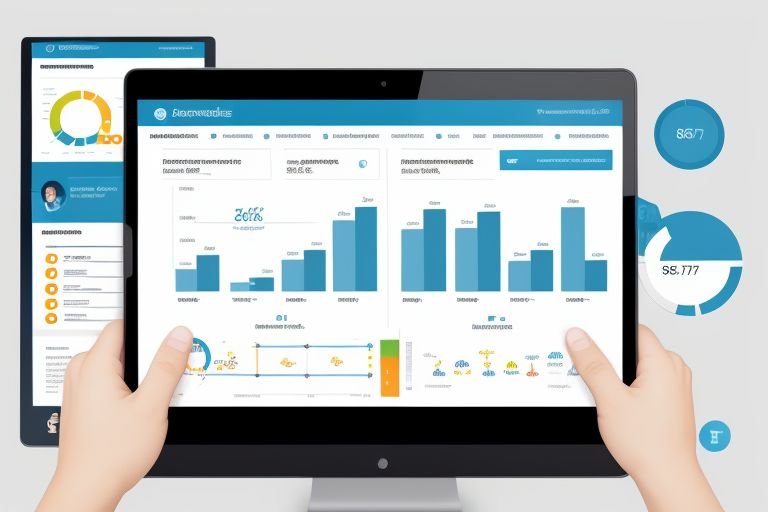How Can Digital Analytics Improve Marketing Strategies And Customer Engagement?

In today’s fast-paced digital landscape, businesses are inundated with data from numerous channels, ranging from social media interactions to website traffic and customer behavior patterns. The challenge lies not only in collecting this data but also in interpreting and utilizing it effectively. Digital analytics emerges as a vital tool that empowers organizations to enhance their marketing strategies and foster deeper customer engagement. This article delves into the various ways digital analytics can improve marketing approaches, enhance customer relationships, and drive business success.
Key Takeaways
- Digital analytics is essential for businesses looking to improve their marketing strategies and enhance customer engagement through data-driven insights.
- By leveraging digital analytics, businesses can make informed decisions, tailor their marketing efforts to specific audience segments, and measure the performance of their campaigns.
- Understanding the customer journey, implementing personalization, and utilizing real-time feedback are critical for fostering deeper customer relationships.
- Investing in the right tools, training personnel, establishing clear objectives, and integrating analytics with marketing strategy are crucial steps for successful implementation.
- In a rapidly evolving digital landscape, businesses that effectively utilize digital analytics will gain a competitive edge, driving growth and customer loyalty.
Understanding Digital Analytics
Definition of Digital Analytics
Digital analytics involves the systematic collection, analysis, and interpretation of data generated by online interactions. This encompasses various metrics related to user behavior, engagement levels, conversion rates, and more. By leveraging digital analytics, businesses can gain insights into how customers interact with their brand across digital platforms.
Importance of Digital Analytics in Marketing
In a digital-first world, understanding customer preferences, behaviors, and engagement patterns is crucial for effective marketing. Digital analytics provides businesses with the information needed to make informed decisions, optimize marketing efforts, and ultimately, drive sales and growth.
Enhancing Marketing Strategies Through Digital Analytics
Data-Driven Decision Making
One of the most significant advantages of digital analytics is its ability to facilitate data-driven decision-making. By analyzing customer data, businesses can identify trends and patterns that inform marketing strategies. This data-driven approach reduces reliance on gut feelings or assumptions, enabling marketers to base their campaigns on factual insights.
Example: Targeted Advertising
For instance, a retail company can analyze customer purchase data to identify trends in buying behavior. If analytics reveal that certain products are frequently bought together, the company can create targeted advertising campaigns to promote these items as bundles, enhancing customer appeal and increasing sales.
Audience Segmentation

Digital analytics enables businesses to segment their audience based on various criteria, such as demographics, behaviors, and preferences. By understanding the different segments within their customer base, marketers can tailor their messages and offers to meet the specific needs of each group.
Example: Personalized Marketing Campaigns
A travel agency might use digital analytics to segment its audience into families, solo travelers, and adventure seekers. By crafting personalized marketing campaigns for each segment, the agency can provide more relevant content, leading to higher engagement rates and conversion.
Performance Measurement and Optimization
Another critical aspect of digital analytics is its ability to measure marketing performance. By tracking key performance indicators (KPIs), businesses can evaluate the effectiveness of their marketing campaigns in real-time. This allows for timely adjustments and optimizations based on what is or isn’t working.
Example: A/B Testing
A/B testing is a common method used in digital analytics to compare two versions of a marketing campaign. By analyzing which version performs better, businesses can optimize their campaigns for maximum impact, ensuring that marketing resources are allocated efficiently.
Enhanced Content Strategy
Digital analytics provides insights into the types of content that resonate with customers. By analyzing engagement metrics such as clicks, shares, and time spent on page, businesses can identify which content formats and topics are most appealing to their audience.
Example: Content Marketing
A company that specializes in fitness may analyze its blog posts and social media content to see which topics generate the most engagement. By focusing on high-performing content areas, the company can refine its content strategy to align with customer interests, driving more traffic and engagement.
Fostering Customer Engagement Through Digital Analytics
Understanding Customer Journey
Digital analytics allows businesses to map out the customer journey, providing insights into the various touchpoints a customer interacts with before making a purchase. Understanding this journey is essential for optimizing marketing efforts and improving customer experiences.
Example: Customer Journey Mapping
A software company might analyze data from its website, social media, and customer support interactions to map out the customer journey. This analysis can reveal bottlenecks or pain points in the journey, allowing the company to make necessary improvements, such as enhancing its website navigation or providing more helpful content.
Real-Time Feedback and Adaptation
With digital analytics, businesses can receive real-time feedback on customer interactions and engagement. This immediate access to data allows companies to adapt their strategies quickly and effectively, responding to customer needs and preferences as they evolve.
Example: Social Media Engagement
A brand monitoring its social media channels can quickly see which posts generate the most engagement. If a particular type of content (e.g., video tutorials) performs well, the brand can pivot its content strategy to focus more on similar formats, increasing overall engagement.
Building Relationships Through Personalization

Digital analytics enables businesses to personalize customer interactions based on data-driven insights. By understanding customer preferences and behaviors, businesses can create tailored experiences that foster stronger relationships with their audience.
Example: Personalized Email Campaigns
An e-commerce retailer can analyze customer browsing and purchase history to send personalized email recommendations. This level of personalization enhances customer engagement, as individuals are more likely to respond to offers that align with their interests.
Customer Retention Strategies
Engagement does not end with a purchase; retaining customers is equally important. Digital analytics can help identify patterns that indicate potential churn, allowing businesses to implement strategies to retain customers.
Example: Churn Prediction
A subscription-based service may analyze user activity data to identify customers who have decreased engagement. By proactively reaching out with incentives or personalized offers, the service can improve customer retention rates and maintain a loyal user base.
Implementing Digital Analytics in Marketing
Choosing the Right Tools
To harness the power of digital analytics, businesses must invest in the right tools and technologies. There are numerous analytics platforms available, each offering various features and capabilities. Selecting the right tool depends on the business’s specific needs and objectives.
Example: Google Analytics
Google Analytics is one of the most widely used tools for tracking website performance and user behavior. It provides a wealth of data, including visitor demographics, traffic sources, and conversion rates, enabling businesses to make informed decisions.
Training and Skill Development
Incorporating digital analytics into marketing strategies requires personnel trained in data analysis and interpretation. Businesses should invest in training programs to equip their marketing teams with the necessary skills to leverage analytics effectively.
Example: Analytics Training Workshops
A marketing agency might conduct workshops to train its staff on data analysis techniques and tools. This investment in skill development can enhance the agency’s ability to create data-driven campaigns, ultimately improving client outcomes.
Establishing Clear Objectives

Before diving into digital analytics, businesses must establish clear objectives for their marketing efforts. Understanding what they hope to achieve will guide their analytics strategy and ensure that data collected aligns with overarching goals.
Example: SMART Goals
Using the SMART criteria (Specific, Measurable, Achievable, Relevant, Time-bound), a business can set clear marketing objectives, such as increasing website traffic by 30% over six months. This clarity will help focus analytics efforts and drive meaningful results.
Integrating Analytics with Marketing Strategy
Digital analytics should be seamlessly integrated into the overall marketing strategy. This means incorporating data insights into decision-making processes and ensuring that all marketing activities are aligned with the findings from analytics.
Example: Cross-Channel Strategy
A retail brand might analyze data from both online and offline channels to develop a cohesive marketing strategy. By understanding how online behavior influences in-store purchases, the brand can create a more integrated customer experience.
Also Read : The Role Of AI In Marketing Automation: A Critical Perspective
Conclusion
In an increasingly digital world, the ability to harness data through digital analytics is a game changer for businesses striving to optimize their marketing strategies and engage customers meaningfully. By leveraging insights derived from data, companies can tailor their approaches to meet the unique needs and preferences of their audience, ultimately driving higher conversion rates and fostering long-term loyalty.
As digital analytics continues to evolve, staying ahead of the curve will require organizations to embrace data-driven cultures and invest in the necessary tools and training. By prioritizing digital analytics, businesses can unlock the full potential of their marketing efforts and create customer experiences that resonate deeply and lead to sustained success.
FAQs
What is digital analytics?
Digital analytics refers to the systematic collection, analysis, and interpretation of data generated from online interactions to inform marketing strategies and enhance customer engagement.
How does digital analytics improve marketing strategies?
Digital analytics improves marketing strategies by enabling data-driven decision-making, audience segmentation, performance measurement, content strategy enhancement, and targeted advertising.
What tools are commonly used for digital analytics?
Common tools used for digital analytics include Google Analytics, Adobe Analytics, Mixpanel, HubSpot, and various social media analytics platforms.
How can digital analytics enhance customer engagement?
Digital analytics enhances customer engagement by providing insights into customer journeys, enabling real-time feedback, facilitating personalization, and informing customer retention strategies.
What role does audience segmentation play in digital analytics?
Audience segmentation allows businesses to categorize their customers based on demographics, behaviors, and preferences, enabling more tailored marketing messages and offers.
How can businesses measure the effectiveness of their marketing campaigns?
Businesses can measure the effectiveness of marketing campaigns by tracking key performance indicators (KPIs) such as conversion rates, engagement metrics, and return on investment (ROI).
What are some examples of data-driven decision-making in marketing?
Examples of data-driven decision-making include using customer purchase history to create targeted email campaigns, analyzing website traffic patterns to optimize user experience, and leveraging social media engagement metrics to inform content strategy.




